电气工程专业英语section_2-4.
- 格式:ppt
- 大小:162.00 KB
- 文档页数:18
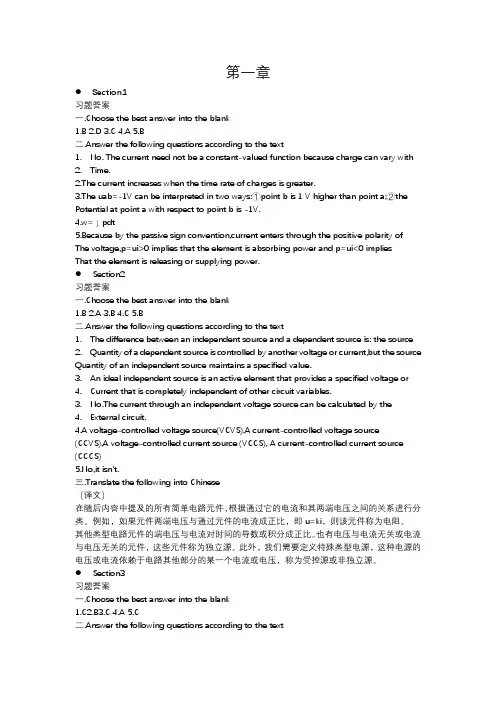
第一章⚫Section1习题答案一.Choose the best answer into the blank1.B2.D3.C4.A5.B二.Answer the following questions according to the text1.No. The current need not be a constant-valued function because charge can vary with2.Time.2.The current increases when the time rate of charges is greater.3.The uab=-1V can be interpreted in two ways:①point b is 1 V higher than point a;②the Potential at point a with respect to point b is -1V.4.w=∫pdt5.Because by the passive sign convention,current enters through the positive polarity ofThe voltage,p=ui>0 implies that the element is absorbing power and p=ui<0 impliesThat the element is releasing or supplying power.⚫Section2习题答案一.Choose the best answer into the blank1.B2.A3.B4.C5.B二.Answer the following questions according to the text1.The difference between an independent source and a dependent source is: the source2.Quantity of a dependent source is controlled by another voltage or current,but the source Quantity of an independent source maintains a specified value.3.An ideal independent source is an active element that provides a specified voltage or4.Current that is completely independent of other circuit variables.3.No.The current through an independent voltage source can be calculated by the4.External circuit.4.A voltage-controlled voltage source(VCVS),A current-controlled voltage source (CCVS),A voltage-controlled current source (VCCS), A current-controlled current source (CCCS)5.No,it isn’t.三.Translate the following into Chinese(译文)在随后内容中提及的所有简单电路元件,根据通过它的电流和其两端电压之间的关系进行分类。
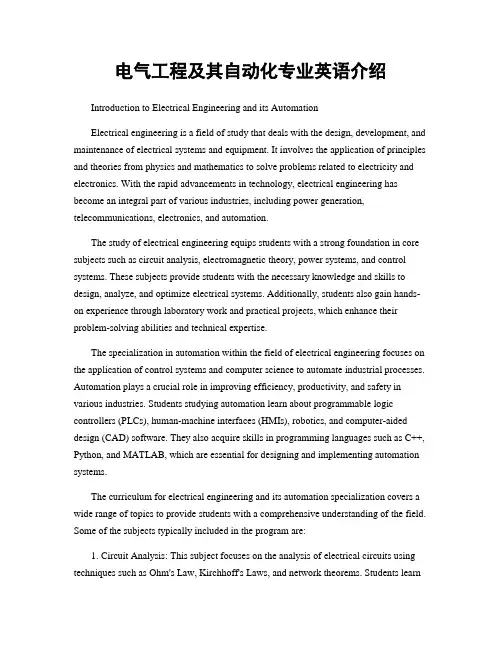
电气工程及其自动化专业英语介绍Introduction to Electrical Engineering and its AutomationElectrical engineering is a field of study that deals with the design, development, and maintenance of electrical systems and equipment. It involves the application of principles and theories from physics and mathematics to solve problems related to electricity and electronics. With the rapid advancements in technology, electrical engineering has become an integral part of various industries, including power generation, telecommunications, electronics, and automation.The study of electrical engineering equips students with a strong foundation in core subjects such as circuit analysis, electromagnetic theory, power systems, and control systems. These subjects provide students with the necessary knowledge and skills to design, analyze, and optimize electrical systems. Additionally, students also gain hands-on experience through laboratory work and practical projects, which enhance their problem-solving abilities and technical expertise.The specialization in automation within the field of electrical engineering focuses on the application of control systems and computer science to automate industrial processes. Automation plays a crucial role in improving efficiency, productivity, and safety in various industries. Students studying automation learn about programmable logic controllers (PLCs), human-machine interfaces (HMIs), robotics, and computer-aided design (CAD) software. They also acquire skills in programming languages such as C++, Python, and MATLAB, which are essential for designing and implementing automation systems.The curriculum for electrical engineering and its automation specialization covers a wide range of topics to provide students with a comprehensive understanding of the field. Some of the subjects typically included in the program are:1. Circuit Analysis: This subject focuses on the analysis of electrical circuits using techniques such as Ohm's Law, Kirchhoff's Laws, and network theorems. Students learnto analyze and solve complex circuits to determine voltage, current, and power distributions.2. Electromagnetic Theory: This subject deals with the study of electromagnetic fields and their interactions with electrical systems. Students learn about Maxwell's equations, electromagnetic wave propagation, and the behavior of electromagnetic devices such as transformers and motors.3. Power Systems: This subject covers the generation, transmission, and distribution of electrical power. Students learn about power generation technologies, power system components, and the design of electrical grids. They also study power system protection and control to ensure the reliable operation of power networks.4. Control Systems: This subject focuses on the analysis and design of control systems to regulate and optimize the behavior of dynamic systems. Students learn about feedback control, PID controllers, stability analysis, and system modeling. They also gain practical experience in designing and implementing control systems through laboratory experiments.5. Digital Electronics: This subject introduces students to the fundamentals of digital logic circuits and systems. They learn about Boolean algebra, logic gates, flip-flops, and sequential logic. Students also gain hands-on experience in designing and testing digital circuits using simulation software and hardware components.6. Automation and Robotics: This subject explores the principles and applications of automation and robotics in industrial processes. Students learn about industrial automation technologies, robotic manipulators, and sensor integration. They also study topics such as motion planning, trajectory control, and machine vision.7. Computer Programming: This subject provides students with the necessary programming skills to develop software for electrical engineering applications. Students learn programming languages such as C++, Python, and MATLAB. They also gain experience in algorithm development, data analysis, and simulation techniques.Upon graduation, students with a degree in electrical engineering and its automation specialization have excellent career prospects. They can work in various industries, including power generation companies, telecommunications firms, manufacturing companies, and automation solution providers. Job roles for electrical engineering graduates include electrical design engineer, control systems engineer, automation engineer, power systems engineer, and research scientist.In conclusion, electrical engineering and its automation specialization offer students a comprehensive understanding of electrical systems and their automation. The program equips students with theoretical knowledge, practical skills, and programming expertise to design, analyze, and optimize electrical systems. With the increasing demand for automation in various industries, graduates in this field have promising career opportunities.。
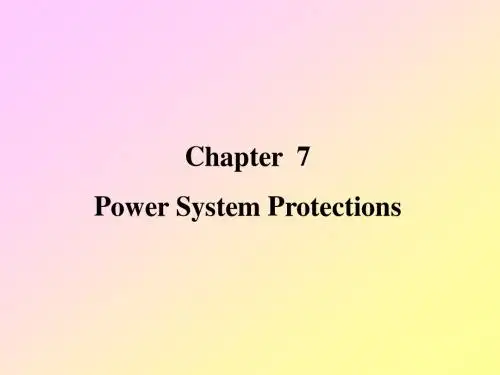
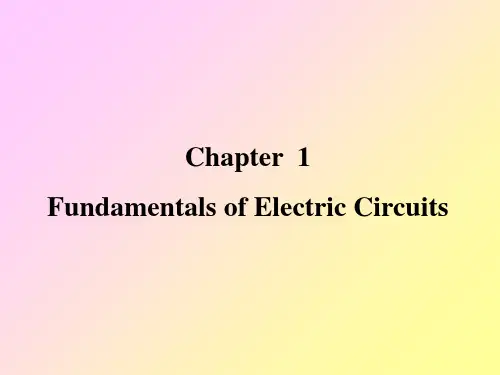
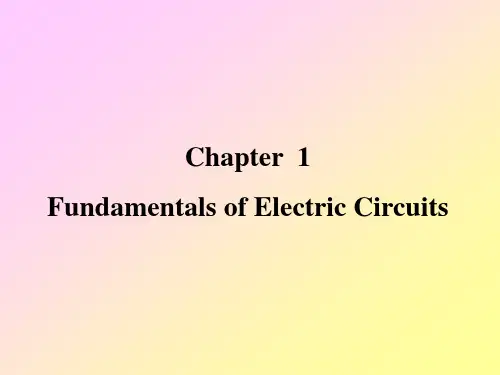
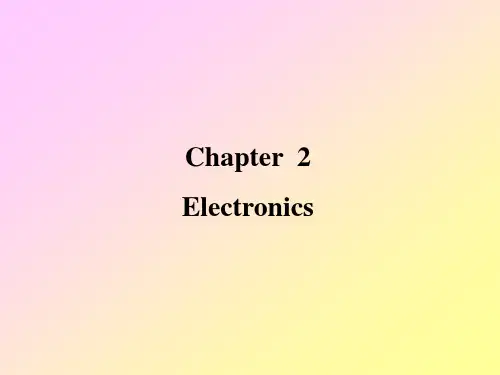
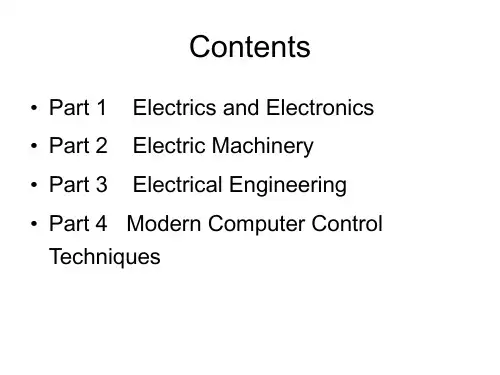
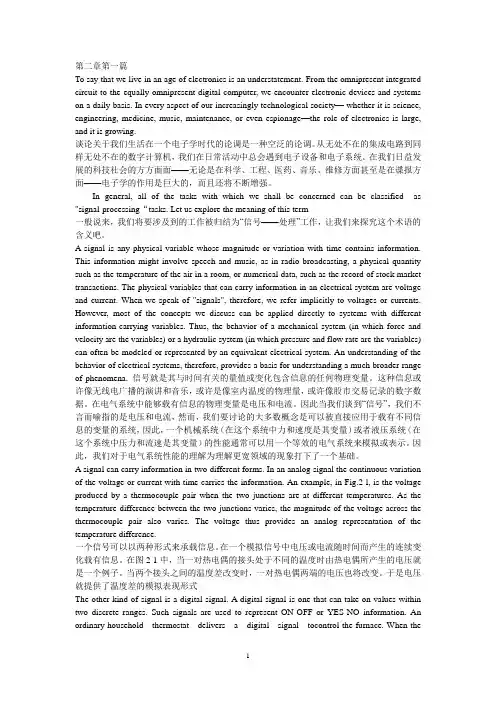
第二章第一篇To say that we live in an age of electronics is an understatement. From the omnipresent integrated circuit to the equally omnipresent digital computer, we encounter electronic devices and systems on a daily basis. In every aspect of our increasingly technological society— whether it is science, engineering, medicine, music, maintenance, or even espionage—the role of electronics is large, and it is growing.谈论关于我们生活在一个电子学时代的论调是一种空泛的论调。
从无处不在的集成电路到同样无处不在的数字计算机,我们在日常活动中总会遇到电子设备和电子系统。
在我们日益发展的科技社会的方方面面——无论是在科学、工程、医药、音乐、维修方面甚至是在谍报方面——电子学的作用是巨大的,而且还将不断增强。
In general, all of the tasks with which we shall be concerned can be classified as "signal-processing“tasks. Let us explore the meaning of this term一般说来,我们将要涉及到的工作被归结为“信号——处理”工作,让我们来探究这个术语的含义吧。
A signal is any physical variable whose magnitude or variation with time contains information. This information might involve speech and music, as in radio broadcasting, a physical quantity such as the temperature of the air in a room, or numerical data, such as the record of stock market transactions. The physical variables that can carry information in an electrical system are voltage and current. When we speak of "signals", therefore, we refer implicitly to voltages or currents. However, most of the concepts we discuss can be applied directly to systems with different information-carrying variables. Thus, the behavior of a mechanical system (in which force and velocity are the variables) or a hydraulic system (in which pressure and flow rate are the variables) can often be modeled or represented by an equivalent electrical system. An understanding of the behavior of electrical systems, therefore, provides a basis for understanding a much broader range of phenomena. 信号就是其与时间有关的量值或变化包含信息的任何物理变量。

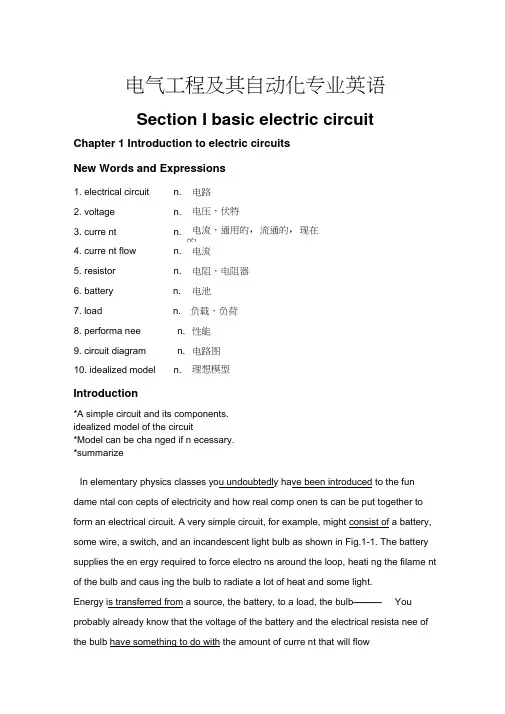
电气工程及其自动化专业英语Section I basic electric circuitChapter 1 Introduction to electric circuitsNew Words and Expressions1. electrical circuit n. 电路2. voltage n. 电压,伏特3. curre nt n. 电流,通用的,流通的,现在的4. curre nt flow n. 电流5. resistor n. 电阻,电阻器6. battery n. 电池7. load n. 负载,负荷8. performa nee n. 性能9. circuit diagram n. 电路图10. idealized model n. 理想模型Introduction*A simple circuit and its components.idealized model of the circuit*Model can be cha nged if n ecessary.*summarizeIn elementary physics classes you undoubtedly have been introduced to the fun dame ntal con cepts of electricity and how real comp onen ts can be put together to form an electrical circuit. A very simple circuit, for example, might consist of a battery, some wire, a switch, and an incandescent light bulb as shown in Fig.1-1. The battery supplies the en ergy required to force electro ns around the loop, heati ng the filame nt of the bulb and caus ing the bulb to radiate a lot of heat and some light.Energy is transferred from a source, the battery, to a load, the bulb———You probably already know that the voltage of the battery and the electrical resista nee of the bulb have something to do with the amount of curre nt that will flowin the circuit. From your own practical experienee you also know that no current will flow until the switch is closed. That is, for a circuit to do anything, the loop has to be completed so that electro ns can flow from the battery to the bulb and the n back aga in to the battery. And fin ally, you probably realize that it doesn t much matter, whether there is on e foot or two feet of wire connecting the battery to the bulb, but that it probably would matter if there is a mile of wire between it and the bulb.Also shown in Fig. 1-1 is a model made up of idealized components. The batteryis modeled as an ideal source that puts out a constant voltage, VB, no matter what amount of curre nt, i, is draw n. The wires are con sidered to be perfect con ductors that offer no resista nee to curre nt flow. The switch is assumed to be ope n or closed. There is no arcing of curre nt across the gap whe n the switch is ope ned, nor is there any bounce to the switch as it makes con tact on closure. The light bulb is modeled as a simple resistor, R, that never changes its value, no matter how hot it becomes or how much curre nt is flow ing through it.Fig. 1-1 (a) A simple circuit(b) An idealized represe ntati on of thecircuitFor most purposes, the idealized model shown in Fig. 1-1b is an adequate represe ntati on of the circuit; that is, our prediction of the current that will flow through the bulb whenever the switch is closed will be sufficiently accurate that we can consider the problem solved. There may be times, however, when the model is in adequate. The battery voltage, for example, may drop as more and more curre nt is drawn, or as the battery ages. --------------------------------- T he light bulb' s resistance may change as it heats up, and the filame nt may have a bit of inductance and capacitance associated with it as well as resistance so that when the switch is closed, the current may not jump in sta ntan eously from zero to some fin al, steady state value. The wires may beundersized, and some of the power delivered by the battery may be lost in the wires before it reaches the load. These subtle effects may or may not be important, depending on what we are trying to find out and how accurately we must be able to predict the performa nee of the circuit. If we decide they are importa nt, we can always cha nge the model as n ecessary and then proceed with the an alysis. The point here is simple. The comb in ati ons of resistors, capacitors, in ductors, voltage sources, curre nt sources, and so forth, that you see in a circuit diagram are merely models of real comp onents that comprise a real circuit, and a certa in amount of judgme nt is required to decide how complicated the model must be before sufficie ntly accurate results can be obta in ed. For our purposes, we will be using very simple models in general, leav ing many of the complicati ons to more adva need textbooks.Chapter 2Definitions of key electrical quantitiesNew Words and Expressionscharge n. vt.电荷;充电nu cleus n.原子核(pl.); nuclear adj.n egative n.否定,负数,底片adj.否定的,消极的,负的,阴性的positive adj.[数]正的adj.[电]阳的in gen eral 通常,大体上,一般而言,总的说来algebraic adj.代数的,关于代数学的soluti on to the circuit problem n.关于电路问题的解法the un its of power n.功率的单位direct curre nt (dc) n 直流电alter nat ing curre nt(ac) n.交流电sinu soidally adv.正弦地tran sistor n.晶体管Part 1 Charge and CurrentAn atom con sists of a positively charged nu cleus surro un ded by a swarm of n egativelycharged electr ons. The charge associated with one electr on has bee n found to be 1.602 x 10- 19 coulombs; or, stated the other way around, one coulomb can be defined as the charge on 6.242 x 1018 electro ns. While most of the electr ons associated with an atom are tightly bound to the nu cleus, good con ductors, like copper, have free electrons that are sufficie ntly dista nt from their nu clei that their attract ion to any particular n ucleus is easily overcome. These con ducti on electr ons are free to wan der from atom to atom, and their moveme nt con stitutes an electric curre nt.In a wire, when one coulomb ' s worth of charge passes a given spot in one second, the current is defined to be one ampere (abbreviated A), named after the nineteenth-century physicist Andr ' e Marie Amp'ere. That is, curre nt i is the net rate of flow of charge q past a point, or through an area:i=d q/d t (1.1)In general, charges can be negative or positive. For example, in a neon light, positive ions move in one direct ion and n egative electr ons move in the other. Each con tributes to curre nt, and the total curre nt is their sum. By conven ti on, the direct ion of curre nt flow is take n to be the direct ion that positive charges would move, whether or not positive charges happen to be in the picture. Thus, in a wire, electrons moving to the right constitute a current that flows to the left, as shown in Fig.1-2.(〉)dq--- / =—dtFig. 1-2 By conven tio n, n egative charges movi ng in one direct ion con stitute a positive curre ntflow in the opposite direct ionW/hen charge flows at a steady rate in one direction only, the current is said to be direct current, or 血A battery, for example, supplies direct curre nt. When charge flows back and forth sinusoidally, it is said to be alternating current, or ac. In the United States the ac electricity delivered by tes of ac and dc are show n in Fig.1-3.Time ―(a)Fig. 1-3 (a) Steady-state direct curre nt (de) (b) Alter nat ing curre nt(ac)Part 2 Kirchhoff' s Current LawTwo of the most fun dame ntal properties of circuits were established experime ntally a cen tury and a half ago by a Germa n professor, Gustav Robert Kirchhoff (1824 - 1887). The first property, known as Kirchhoff ' s current law (abbreviated KCL), states that at every instant of time the sum of the curre nts flow ing into any node of a circuit must equal the sum of the curre nts leavi ng the no de, where a node is any spot where two or more wires are join ed. This is a very simple, but powerful con cept. It is in tuitively obvious once you assert that curre nt is the flow of charge, and that charge is con servative—n either being created nor destroyed as it en ters a no de. Uni ess charge somehow builds up at a no de, which it does not, the n the rate at which charge en ters a node must equal the rate at which charge leaves the no de.There are several alter native ways to state Kirchhoff ' s curre nt law. The most com monly used stateme nt says that the sum of the curre nts flow ing into a node is zero as show n in Fig. 1-4a, in which case some of those curre nts must have n egative values while some have positive values. Equally valid would be the stateme nt that the sum of the curre nts leav ing a node must be zero as show n in Fig. 1-4b(aga in some of these curre nts n eed to have positive values and some n egative). Fin ally, we could say that the sum of the curre nts en teri ng a node equals the sum of the curre nts leav ing a node (Fig. 1-4c). These are all equivale nt as long as we un dersta nd what is meant about the directi on of curre nt flow whe n we in dicate it with an arrow on a circuit diagram. Curre nt that actually flows in the directi on show n by the arrow is give n a positive sig n. Curre nts that actuallyflow in the opposite direct ion have n egative values.(a) The sum of the curre nts into a node equals zero(b) The sum of the curre nts leav ing the node is zero(c) The sum of the curre nts en teri ng a node equals the sum of the curre nts leavi ng the node Note that you can draw curre nt arrows in any directio n that you want — that much is arbitrary — but once havi ng draw n the arrows, you must the n write Kirchhoff ' s curre nt law in a manner that is con siste nt with your arrows, as has bee n done in Fig.1-4. The algebraic soluti on to the circuit problem will automatically determ ine whether or not your arbitrarily determ ined direct ions for curre nts were correct.Example 1.1 Using Kirchhoff ' s Current LawA node of a circuit is shown with current direction arrows chosen arbitrarily. Havingpicked those directi on s, i1 = - 5 A, i2 = 3 A, and i3 = - 1 A. Write an expressi on for Kirchhoff ' s current law and solve for i4.Solution. By Kirchhoff ' s current law,i1 + i2 = i3 + i4 so thatThat is, i4is actually 1 A flowi ng into the no de. Note that i2, i3, and i4 are all en teri ng the no de, and i1 is the only curre nt that is leavi ng the no de.Part 3 Kirchhoff ' s Voltage LawElectr ons won ' t flow through a circuit uni ess they are give n some en ergy to help send them on their way. That “ push ” is measured in volts, where voltage is defi ned to be the amount nodenodenode1 + i4 i4 = - 1 AFig. 1-4 lllustrating various ways that Kirchhoff ' s current law can be statedof en ergy (w, joules) give n to a un it of charge,v=dw/dq A 12-V battery therefore gives 12 joules of en ergy to each coulomb of charge that it stores. Note that the charge does not actually have to move for voltage to have meaning. Voltage describes the potential for charge to do work.While curre nts are measured through a circuit comp onent, voltages are measured across componen ts. Thus, for example, it is correct to say that curre nt through a battery is 10 A, while the voltage across that battery is 12 V. Other ways to describe the voltage across a comp onent in clude whether the voltage rises across the comp onent or drops. Thus, for example, for the simple circuit in Fig. 1-1, there is a voltage rise across the battery and voltage drop across the light bulb. Voltages are always measured with respect to someth ing. That is, the voltage of the positive terminal of the battery is“ so many volts ” with respect to the negative terminal; or, the voltage at a point in a circuit is some amount with respect to some other poin t. In Fig. 1-5, curre nt through a resistor results in a voltage drop from point A to point B of VAB volts. V A and VB arethe voltages at each end of the resistor, measured with respect to some other point.The reference point for voltages in a circuit is usually desig nated with a ground symbol. While many circuits are actually groun ded — that is, there is a path for curre nt to flow directly into the earth —some are not (such as the battery, wires, switch, and bulb in a flashlight). When a ground symbol is show n on a circuit diagram, you should con sider it to be merely a reference point at which thevoltage is defi ned to be zero. Fig.1-6 points out how cha nging the node labeled as ground cha nges the voltages at each node in the circuit, but does not cha nge the voltage drop across each comp onent.(1-2)Fig. 1-5 The voltage drop from point A to point B is V AB, where VAB = VA - VBThe sec ond of Kirchhoff ' s fun dame ntal laws states that the sum of the voltages around any loop of a circuit at any instant is zero. This is known as Kirchhoff ' s voltage law (KVL). Just as was the case for Kirchhoff ' s curre nt law, there are alter native, but equivale nt, ways of stat ing KVL. We can, for example, say that the sum of the voltage rises in any loop equals the sum of the voltagedrops around the loop. Thus in Fig. 1-6, there is a voltage rise of 12 V across the battery and avoltage drop of 3 V across R1 and a drop of 9 V across R2. ------------- Notice that it doesn' t matterwhich node was labeled ground for this to be true. Just as was the case with Kirchhoff ' s current law, we must be careful about labeli ng and in terpret ing the sig ns of voltages in a circuit diagram in order to write the proper vers ion of KVL. A plus (+) sig n on a circuit comp onent in dicates a reference direct ion un der the assumpti on that the pote ntial at that end of the comp onent is higher than the voltage at the other end. Aga in, as long as we are con siste nt in writi ng Kirchhoff ' s voltage law, the algebraic soluti on for the circuit will automatically take care of sig ns.Part 5 Summary of Principal Electrical QuantitiesThe key electrical qua ntities already in troduced and the releva nt relati on ships betwee n these quantities are summarized in Table 1-1.Since electrical quantities vary over such a large range of magnitudes, you will often find yourself work ing with very small qua ntities or very large qua ntities. For example, the voltage created by your TV antenna may be measured in millionths of a volt (microvolts, 卩V), while the power gen erated by a large power stati on may be measured in billi ons of watts, or gigawatts (GW). To describe quantities that may take on such extreme values, it is useful to have a system of prefixes that accompany the units. The most commonly used prefixes in electrical engineering are give n in Table 1-2.Part 6 Ideal Voltage Source and Ideal Current SourceElectric circuits are made up of a relatively small nu mber of differe nt kinds of circuiteleme nts, or comp onen ts, which can be in terc onn ected in an extraord in arily large nu mber of ways.At this point in our discussion, we will concentrate on idealized characteristics of these circuit eleme nts, realiz ing that real comp onents resemble, but do not exactly duplicate, the characteristics that we describe here.An ideal voltage source is one that provides a give n, known voltage vs, no matter what sort ofload it is conn ected to. That is, regardless of the curre nt draw n from the ideal voltage source, it will always provide the same voltage. Note that an ideal voltage source does not have to deliver a con sta nt voltage; for example, it may produce a sinu soidally vary ing voltage —the key is that voltage is not a fun ctio n of the amount of curre nt draw n. A symbol for an ideal voltage source is show n in Fig. 1-7.A special case of an ideal voltage source is an ideal battery that provides a con sta nt dc output, as show n in Fig. 1-8. A real battery approximates the ideal source; but as curre nt in creases, the output drops somewhat. To acco unt for that drop, quite ofte n the model used for a real battery is an ideal voltage source in series with the internal resista nee of the battery.An ideal curre nt source produces a give n amount of curre nt is no matter what load it sees. As show n in Fig. 1-9, a commo nly used symbol for such a device is circle with an arrow in dicati ng the directi on of curre nt flow. While a battery is a good approximati on to an ideal voltage source, there is nothing quite so familiar that approximates an ideal curre nt source. Some tran sistor circuits come close to this ideal and are ofte n modeled with idealized curre nt sources.Section II The electric power systemChapter 1 Brief Introduction to The Electric Power SystemNew Words and ExpressionsMinimum a 最小prime mover n 原动机gen erator n 发电机load n 负载furn ace n 炉膛boiler n 锅炉fissi on able n 可裂变的fissi on able material 核燃料Part 1 Minimum Power systemelevatio n n 高度,海拔internal combusti on engine 内燃机 steam-drive n turbi ne 汽轮机hydraulic turbi ne 水轮机convert v 变换,转换 shaft n 传动轴,轴 torquen 力矩servomecha nism n 伺服机构* Elements of a minimum electric power system *Types of energy source *Types of prime mover *Types of electrical load*Functions of the control systemA minimum electric power system is shown in Fig.1-1, the system consists of an energy source, a prime mover, a generator, and a load.The en ergy source may be coal, gas, or oil burned in a furnace to heat water and gen erate steam in a boiler; it may be fissi on able material which, in a nu clear reactor, will heat water to produce steam; it may be water in a pond at an elevatio n above the gen erat ing stati on; or it may be oil or gas burned in an internal combusti on engine.The prime mover may be a steam-driven turbine, a hydraulic turbine or water wheel, or aninternal combustion engine. Each one of these prime movers has the ability to convert energy in the form of heat, falling water, or fuel into rotation of a shaft, which in turn will drive theEnergy source Prime nioverGenerator Lx>adContjolFig* 1-1 The tninfnmm electric power systemgen erator.The electrical load on the gen erator may be lights, motors, heaters, or other devices, alone or in comb in ati on. Probably the load will vary from mi nute to min ute as differe nt dema nds occur. The control system functions (are ) to keep the speed of the machines substantially constant and the voltage within prescribed limits, even though the load may cha nge. To meet these load con diti on s, it is n ecessary for fuel in put to cha nge, for the prime mover in put to vary, and for the torque on the shaft from the prime mover to cha nge in order that the gen erator may be kept at con sta nt speed. In additi on, the field curre nt to the gen erator must be adjusted to maintain con sta nt output voltage. The con trol system may in clude a man stati oned in the power pla nt who watches a set of meters on the gen erator output term in als and makes the n ecessary adjustme nts manu ally .In a moder n stati on, the con trol system is a servomecha nism that sen ses gen erator-output con diti ons and automatically makes the n ecessary cha nges in en ergy in put and field curre nt to hold the electrical output with in certa in specificati ons.Part 2 More Complicated Systems*Foreword*Cases of power system with out circuit breaker *Power system with circuit breakerNew Words and Expressions1. associated2. circuit3. circuit breaker4. dee nergize5. dee nergized6. outage n7. diagram8. switch out of9. switch offIn most situati ons the load is not directly conn ected to the gen erator term in als. More com monlya 联接的 n 电路n 断路器 vt 切断,断电 adj 不带电的停电 n 简图退出来,断开 v 切断,关闭the load is some distanee from the generator, requiring a power line connecting them. It is desirable to keep the electric power supply at the load with in specificati ons. However, the con trols are near the generator, which may be in another building, perhaps several miles away.If the dista nce from the gen erator to the load is con siderable, it may be desirable to in stall transformers at the generator and at the load end, and to transmit the power over a high-voltage line (Fig.1-2). For the same power, the higher-voltage line carries less current, has lower losses for the same wire size, and provides more stable voltage., TransformerTransformerPrime 〔Mover Generator f C High-voltage line—Fig- 1-2 A generator connected through transformers anda high-voltage line to a distant loadIn some cases an overhead line may be un acceptable. In stead it may be adva ntageous to use an un dergro und cable. With the power systems talked above, the power supply to the load must be in terrupted if, for any reas on, any comp onent of the system must be moved from service for maintenance or repair.Additi onal system load may require more power tha n the gen erator can supply. Ano ther gen erator with its associated tran sformers and high-voltage line might be added.It can be shown that there are some advantages in making ties between the generators (1) and at the end of the high-voltage lines (2 and 3), as shown in Fig.1-3. This system will operate satisfactorily as long as no trouble develops or no equipment needs to be taken out of service.Kig. 1-3 A system with para)lei operation or the generators t of the transformers andof the transmission lintsThe above system may be vastly improved by the in troducti on of circuit breakers, which may be ope ned and closed as n eeded. Circuit breakers added to the system, Fig.1-4, permit selected piece of equipme nt to switch out of service without disturb ing the rema in der of system. With this arran geme nt any eleme nt of the system may be dee nergized for maintenance or repair by operati on of circuit breakers. Of course, if any piece of equipme nt is take n out of service, the n the total load must be carried by the remaining equipment. Attention must be given to avoid overloads duri ng such circumsta nces. If possible, outages of equipme nt are scheduled at times when load requireme nts are below no rmal.Low-voltageo=^GeneratorsFig.1-5 shows a system in which three gen erators and three loads are tied together by threeFig* 1-4 A system with necessary circuit breakerstran smissi on lin es. No circuit breakers are show n in this diagram, although many would berequired in such a system.Fis- 1-S Three generators supplying threeloads over hlgh-voltnge trAnsmlsston linesChapter 2 Faults on Power SystemNew Words and Expressions1. fault2. in terfere neen 干扰,防碍6. feed (fed)给。
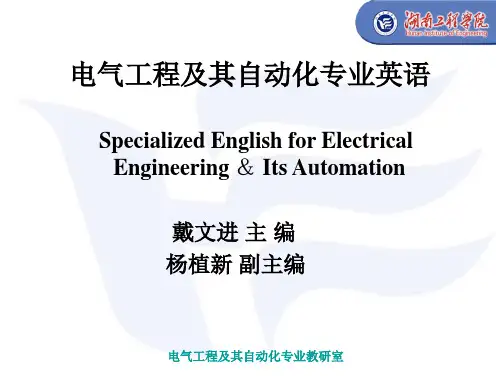
circuit components 电路元件the dielectric 电解质circuit parameters 电路参数storage battery 蓄电池electrical device 电气设备wire导线electric energy 电能 e.m.f.=electromotive force 电动势energy source 电源unidirectional current 单方向电流primary cell 原生电池circuit diagram 电路图secondary cell 再生电池load characteristic 负载特性energy converter 电能转换器terminal voltage 端电压conductor 导体external characteristic 外特性generator 发电机load resistance 负载电阻heating appliance电热器voltage drop 电压降direct-current (D.C.)circuit 直流电路conductance电导magnetic and electric field 电磁场volt-ampere characteristic 伏-安特性time-invariant时不变的metal-filament lamp 金属丝灯泡self-(or mutual-)induction 自(互)感carbon-filament lamp 碳丝灯泡displacement current位移电流non-linear characteristic非线性特性part 1-unit 2ideal source理想电源ideal current source 理想电流源series and parallel equivalent circuit串并联等值电路active circuit elements 有源电路元件internal resistance 内阻passive circuit elements 无源电路元件sending end 发送端power transmission line 输电线double subscript 双下标receiving end 接收端ideal voltage source理想电压源lackage current漏电流part 1-unit 3Ohm’s law 欧姆定律active branch有源支路circuit branch 支路positive reference direction 正(参考)方向reference point 参考点potential distribution电位分布passive element 无源元件single-loop network (circuit )单回路网络(电路)complex circuit 复杂电路 D.C. machine直流电机P.D.=potential drop电压降part 1-unit 4r.m.s values=root of mean sguare 均方根complex number 复数effective values 有效值Cartesian coordinates 笛卡尔坐标系steady direct current 恒稳直流电counter-clockwise 逆时针方向sinusoidal time function 正弦时间函数vector diagrams 矢量图clockwise顺时针方向complex plane复平面trigonometric transformations 三角转换vector of voltages (currents ,magnetic ,fluxes )电压(电流,磁通等)矢量Argand 阿尔冈,法国数学家analytical solution 解析法absolute value 绝对值Argand diagram 阿尔冈图modulus复数模origin of coordinates 坐标原点complex time function 复数的幅值rotating vector 旋转矢量real part 复数实部instantaneous values 瞬时值imaginary part复数虚部epoch angle初相角301&302吐血整理男生版专业英语单词part 1-unit 1complex-number method=method复数法phase displacement相位差of complex numbersvector矢量constant angular velocity恒定角速度Part 1-unit 5small signal amplifier小信号放大器isolation隔离。
Chapter 4 Electric Machinery电机Section 4 Transformer变压器Types and construction of transformer变压器的种类和结构A transformer is a device that changes AC electric energy at one voltage level into AC electric energy at another voltage level through the action of a magnetic field.变压器是一种设备,这种设备通过磁场的作用将一种电压等级的交流电转换成另一种电压等级的交流电。
It consists of two or more coils of wire wrapped around a common ferromagnetic core.变压器油了两个或多个缠绕公用铁芯上的线圈组成。
These coils are (usually) not directly connected.这些线圈通常不是直接连接在一起的。
The only connection between the coils is the common magnetic flux present within the core.线圈之间唯一的连接时存在于铁芯中的公共的磁通。
One of the transformer windings is connected to a source of AC electric power,其中一个变压器的线圈与交流电源连接,and the second (and perhaps third) transformer winding supplies electric power to loads.第二个变压器的线圈(可能是第三个线圈)向负载提供电功率。
第六章Electric Power Systems 电力系统Section 1 Introduction 第一节介绍The modern society depends on the electricity supply more heavily than ever before. 现代社会的电力供应依赖于更多地比以往任何时候。
It can not be imagined what the world should be if the electricity supply were interrupted all over the world. 它无法想象的世界应该是什么,如果电力供应中断了世界各地。
Electric power systems (or electric energy systems), providing electricity to the modern society, have become indispensable components of the industrial world. 电力系统(或电力能源系统),提供电力到现代社会,已成为不可缺少的组成部分产业界的。
The first complete electric power system (comprising a generator, cable, fuse, meter, and loads) was built by Thomas Edison – the historic Pearl Street Station in New York City which began operation in September 1882. 第一个完整的电力系统(包括发电机,电缆,熔断器,计量,并加载)的托马斯爱迪生所建-站纽约市珍珠街的历史始于1882年9月运作。
This was a DC system consisting of a steam-engine-driven DC generator supplying power to 59 customers within an area roughly 1.5 km in radius. The load, which consisted entirely of incandescent lamps, was supplied at 110 V through an underground cable system. 这是一个半径直流系统组成的一个蒸汽发动机驱动的直流发电机面积约1.5公里至59供电范围内的客户。